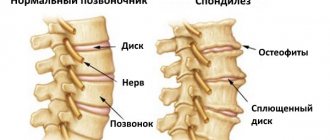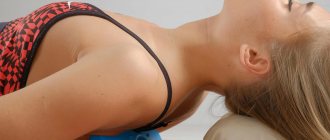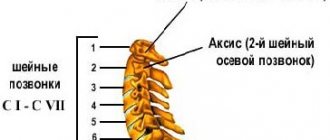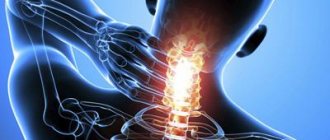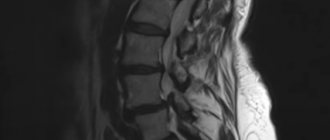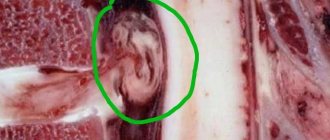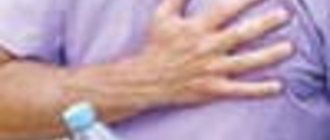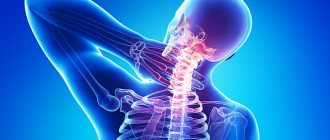What is osteochondrosis
Osteochondrosis is a dystrophic pathology of the cartilaginous surfaces of the bones of the musculoskeletal system - vertebrae and discs.
Intervertebral discs are a kind of shock absorbers that are designed to alleviate pressure on the spine.
The reason for the widespread nature of the disease can be attributed to the predominantly vertical lifestyle of modern man. He spends most of his time sitting or standing, and at the same time the load on the spine increases significantly. So, after some time, the outer shell of the intervertebral disc cracks. The result of this process is the formation of hernias that compress the blood vessels or roots of the spinal cord. These changes lead to impaired blood circulation, the development of pain and reflex tension in the back muscles.
Diagnosis of osteochondrosis of the thoracic region
With osteochondrosis, a person may feel pain in the neck, shoulders and arms, back or chest. Often, patients are in no hurry to turn to specialists, but try to independently determine the root cause of the discomfort. However, this is very dangerous. One has only to imagine: a person suspects a heart problem, although in reality it is a pinched nerve that is aching. What if it's the other way around?
Important!. Never self-medicate! Pain of any nature is a reason to visit a doctor to determine an accurate diagnosis and treatment method.
Drug therapy
Drug therapy is used only in the acute phase of osteochondrosis and when other treatment methods are ineffective.
At the height of the disease, painkillers are prescribed, as well as drugs that speed up metabolic processes. Both medications in the form of tablets and injections help.
Groups of medications prescribed:
- Nonsteroidal anti-inflammatory drugs, which also relieve pain. Available in the form of cream, tablets and ampoules for intravenous or subcutaneous administration.
- Vasodilators. During muscle tension and severe pain, vasoconstriction occurs, as a result, blood pressure may increase and oxygen supply to the brain may become difficult. Vasodilators bring vascular tone back to normal.
- Muscle relaxants. This group of drugs is designed to relax and soothe tense muscles. This effect triggers a chain of beneficial changes such as improved blood circulation, regulation of vascular tone and relief from pain. When blood flow is normalized, damaged tissues are restored faster.
- Chondroprotectors and B vitamins. These are drugs that restore cartilage tissue, stopping the destruction process.
- Complex of sedatives. The stress of pain makes the pain worse. Irritability and anxiety trigger the sympathetic nervous system into action, which leads to even greater tone of muscles and blood vessels. Sedatives and sometimes antidepressants can break this vicious circle.
As you can see, the treatment of osteochondrosis needs to be approached comprehensively, having studied all the nuances. It’s best to turn to specialists, thereby protecting yourself from mistakes.
What symptoms are characteristic of thoracic osteochondrosis?
- pain in the chest area and between the shoulder blades, which is especially noticeable when raising arms, bending over and other physical activity;
- pain intensifies at night, with deep inhalation and exhalation, as well as in case of hypothermia;
- the appearance of “goosebumps” on the skin and numbness of its individual areas;
- itching, burning, cold feet syndrome;
- feeling like a hoop is squeezing my chest.
If a person has noticed at least some of these symptoms, he should definitely contact a neurologist or traumatologist. After listening to the complaints, the doctor will conduct an initial examination of the spinal column and determine whether there are problems with cerebral circulation. One of the important steps in diagnosing the disease is referral for hardware examination. Modern medicine uses a number of methods, the most accurate of which are MRI and CT.
Reflex signs
Symptoms:
- respiratory disorders such as a feeling of lack of air, pain during inhalation and exhalation, difficulty breathing;
- feeling of chills, “goosebumps”;
- feeling of disturbances in the gastrointestinal tract: nausea, loss of appetite, heartburn, diarrhea or constipation, bloating;
- intercostal neuralgia;
- pain in the chest of a girdling nature, between the shoulder blades, during bending and straightening;
- insomnia, feeling tired with enough sleep, fatigue;
- stiffness of movement in the morning;
- worsening gait;
- irritability;
- decreased libido/potency.
Reflex symptoms are more vague than radicular ones and are often misunderstood by doctors. Therefore, it is very important to find a competent doctor who will take the patient’s complaints seriously and prescribe the correct treatment for thoracic osteochondrosis, especially during an exacerbation.
Treatment methods
So, the diagnosis has been established. This means the next stage is the appointment of effective treatment. As a rule, doctors are guided by the characteristics of a particular case and approach the issue of choosing methods individually. There are two types of treatment – conservative and surgical. Which of them will be applied to the patient directly depends on the severity of the disease, the availability of internal resources of the body, as well as indications and contraindications.
What conservative methods are most common:
- taking medications and dietary supplements prescribed by a doctor;
- manual therapy;
- traction;
- acupuncture;
- massage;
- Exercise therapy, etc.
Reference. The human body is a delicate, unique system. If gymnastics helped one patient, this is not an indication for prescribing it to another. The attending physician always selects an individual course based on the physical characteristics of the person.
The main type of treatment for osteochondrosis of the thoracic region is considered to be gentle manual therapy, and massage, medications, etc. play a supporting role.
This is due to the fact that the nutrition of the discs depends on the condition of the muscles surrounding the spinal column. Moreover, the spinal muscles themselves are a component cause of pain in osteochondrosis of the thoracic region. The chiropractor, smoothly influencing the tissue, helps normalize reflexes and muscle tone, eliminates spasms and clamps, relieves and distributes the load from the affected discs, as a result of which the nutrition of the intervertebral discs and spinal circulation improves, and the motor functions of the body are restored.
Treatment in a hospital or sanatorium
Manual therapy
This is an effect on the patient’s body with the help of hands in order to restore metabolism and give the spine the correct shape. The procedure consists of manipulations to restore joint function, relaxing massage to relieve pain and muscle tension, mobilization to improve blood circulation and relaxation.
The duration of treatment is about 3 months.
Massage
In the treatment of degenerative changes in the thoracic spine, both classical therapeutic and acupressure types of massage are used. The massage therapist works with the muscle fibers of the upper back and shoulders in order to influence the thoracic region.
Mineral baths
During the procedure, the hemodynamics of the body changes. This means that blood is directed from the center to the periphery and from there to the heart, which drives it through all organs and tissues. Thus, the following effects are achieved:
- blood circulation improves;
- the nervous system is strengthened;
- The respiratory system and kidneys work better;
- the adaptive properties of the body increase;
- reduction of inflammation;
- relief from pain;
- removal of toxins;
- skin sensitivity increases.
The chemical composition of water affects the effect of a mineral bath on the body of a patient suffering from osteochondrosis. Water temperature affects muscle relaxation and metabolic processes.
Acupuncture
Also, this procedure is called acupuncture or acupuncture. Its essence lies in influencing biological points of the human body with the help of needles. Long and short sterile needles are inserted to a depth of up to 15 mm and left for half an hour.
This seemingly simple procedure has proven itself all over the world. Reviews from patients indicate the following effects after completing a course of acupuncture procedures:
- relaxation;
- cessation of tinnitus and dizziness;
- increasing energy potential;
- improved blood flow;
- improvement of thought processes;
- getting rid of headaches;
- relieving muscle spasms.
Laser therapy
The advantage of laser therapy is improving the penetration of drugs and normalizing the adaptive properties of the body. During the procedure, laser beams of a certain range are exposed to the areas of the spine that need treatment. The result of exposure is an anti-inflammatory effect, normalization of metabolism in the affected area, improvement of general well-being, the process of tissue regeneration starts, and the process of degeneration stops.
As a result of completing a full course of procedures as part of complex therapy, the degenerative process can be completely reversed.
Mud therapy
This procedure is beneficial not only for the spine, but also for the entire body. The only thing is that it cannot be used in the acute phase of osteochondrosis.
The effects of mud therapy include improving the trophism of formations in the intervertebral joints, vascular function, adaptation and recovery processes. Also, the functioning of the nervous system is normalized, pain disappears.
Working with a psychologist
Since with osteochondrosis a person experiences constant stress, anxiety states often develop. A psychologist not only helps to get rid of them, but also stimulates in moments of despair and fatigue. A positive attitude plays an important role in treatment.
Exercise therapy
The treatment procedure is carried out in groups of several people and includes exercises taking into account the individual characteristics of the patient and his medical history. The emphasis is on improving joint function and strengthening the muscle corset. Without exercise, full recovery is unlikely.
Nordic walking
This is one of the most effective types of physical activity for osteochondrosis and it is gaining more and more popularity every year.
While walking with poles, 90% of the muscles become toned, active burning of calories occurs, the load is evenly distributed throughout the body, the cardiovascular system is strengthened, intestinal function is improved, the nervous system and psyche are strengthened, the functions of the respiratory system are improved, insomnia disappears, blood vessels are strengthened, a strong corset is formed around the thoracic spine.
Rehabilitation and lifestyle restoration
Rehabilitation of patients with osteochondrosis requires an integrated approach. To maintain the results of treatment over a long period of time, it is necessary to combine many techniques from various fields of medicine. For example, in addition to following a therapeutic diet, performing special gymnastic exercises and visiting a chiropractor, the patient should include in the list of mandatory procedures:
- Isometric kinesiotherapy;
- Manual therapy;
- Reflexology;
- Underwater hydromassage;
- Traction treatment;
- Magnetic, electrical and vibration stimulation;
- Ultrasound and laser therapy;
- Mobilization-vacuum therapy;
- Psychotherapy.
Important!. At home, it is quite difficult to take into account all the nuances of the rehabilitation period - from training on exercise machines to strict adherence to sleep and wakefulness. Departments of public hospitals do not always have the necessary equipment or personnel. The solution to the problem is often specialized clinics, such as the Kuntsevo Treatment and Rehabilitation Center. Technical equipment, instruments and equipment of world quality standards allow you to undergo effective therapy in a comfortable and safe environment under the supervision of specialized specialists.
Lifestyle with osteochondrosis of the thoracic spine
To prevent the disease, as well as to maintain the general condition of the patient’s body with osteochondrosis, doctors advise:
- Correct spinal curvature and postural disorders in a timely manner.
- Actively engage in sports, which will strengthen your muscles and develop your muscle corset.
- Follow a diet to maintain normal levels of vitamins, micro- and macroelements.
- Fight excess weight.
- Ensure even distribution of the load on the spine if you need to lift something heavy.
- Sit so that your back is straight and your shoulders are relaxed.
- Choose chairs and armchairs that support your back.
- Try to “dilute” static time at work with walking, warming up, and office gymnastics.
- Sleep on an orthopedic mattress.
